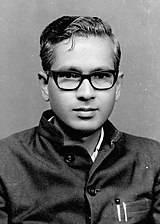Mulukanadu Brahmin
The Mulukanadu Brahmins are a sub-group of Telugu-speaking Vaidiki Smartha Brahmins. Variations of the name of the community include: Murikinadu, Muluknadu, Mulukanadu, Mulakanadu, Moolakanadu and Mulikinadu.
EtymologyEdit
The name Mulukanadu follows the usual conjoint formulation of Brahmin communities: the word Naadu means "country" in all the south Indian languages; this is suffixed to the country whence the community hails, being in this case "Muluka". Thus, Muluka+Naadu=Mulukanadu, "people of the Muluka land." Muluka or Mulaka is identified and it is also known as Moolaka or Moolaka desha along with Ashmaka in shatavahana regime.[1] Aurangabad, Nashik, Jalna, Vashim are parts of Mulaka. Pratishthanapura or present day Paithan is the capital of Mulaka desh.[2][3]
T. V. Venkatachala Sastry's study of caste genealogy and sociology titled Mulukanadu Brahmanar traces the genealogy of the Mulukanadu sect and its origins, customs and prevailing cultures.[4]
Origins of the name
Mulukanadu has been called variously across an assorted array of inscriptions found in the region. The Brahmin community from this sect has an incessant relationship with the Telugu language and it can be deduced that the region corresponding to the origin of this sect is the middle Pennar region which is based entirely in the Cuddapah district. The area is itself known under different names during different periods of time. Dommaranandyala plates inscribed by Punyakumara mentions this region as Hiranya Rashtra. The first inscription that explicitly talks about Mulkinadu is of the Rashtrakuta king Krishna in Pushpagiri as Mulkinadu naidu maharajyam.[5] Along with Mulkinadu, various other locations in the vicinity are called Renadu, Marjavadi, Pottapinadu, Pedanadu and so on.
There is another inscription by the king Kayasta Ambadeva (This is the same king who reigned the southern region of the Andhra Pradesh under the Kakatiya ruler Rudrama Devi) dated Saka 1214 corresponding to 1292 CE. Along with Mulkinadu, he also refers to other regions Penavadi, Pulivendla (Present day Pulivendula), Sirivodu and Pottapi.[5]
Another king of the Kakatiya dynasty Prataprudra who ruled between 1289 CE and 1323 CE had got inscribed in his Chanduvayi inscription in the Siddhavatam Taluk of Cuddapah district about the region of Mulikinadu in the year 1319 CE.[6] The fact that these inscriptions also refer to other regions that are close by attests that the region Mulkinadu or Mulukanadu is indeed a region in Cuddapah district.
See alsoEdit
| Religion | |
|---|---|
| Hinduism of the Smarta tradition. |
The historical version I heard was Mulk in Urdu is land. All the muslim states specially Nizam state was known as Mulk and we were all given Mulki certificates indicating we belong to telangana. From there i heard that this situation of being driven by land where ever Muslim rulers invaded Hindustan and attacked temples those priests had to save their lives by running away from Central Bharat and Maharastra and fortunately Vijayanagaram Kakateeya and southern kings were kind enough to provide a shive temple with adequate lend for temple archana and for their livelihood. Since they came from Mulk [muslim land] and were incharge of shiva temples and smarthas they formed a group of their own identity. As i know there were several educated people tried to bring them together time to time by marriage ties. we can trace their origin to Nanded, Aurangabad Hyderabad, Agra and other erstwhile muslim ruled states.
ReferencesEdit
- ↑ Chennai, Mulukanadu Sabha. "Origins of Mulukanadu Community". Website. Mulukanadu Sabha Chennai. Retrieved 1 December 2013.
- ↑ Sastri, S. Srikanta. ""Mulakas" (Origins of Mulukanadu Sect)". Article. Quarterly Journal of Mythic Society. Retrieved 1 December 2013.
{{cite web}}: CS1 maint: url-status (link) - ↑ Sastry, T. V. Venkatachala (2000). Mulukanadu Brahmanaru. Bangalore: Mulukanadu Mahasangha.
- ↑ Sastri, S. Srikanta. "Featured: T. V. Venkatachala Sastry". A Brief Biographical Sketch. www.srikanta-sastri.org. Retrieved 13 January 2014.
{{cite web}}: CS1 maint: url-status (link) - ↑ 5.0 5.1 Satyamurthy, K. (1991). Medieval Indian Culture and Political Geography. APH Publishing. ISBN 9788170244424.
- ↑ "Full text of "Early History Of The Deccan Pts.7 To 11"". archive.org. Retrieved 6 September 2017.
